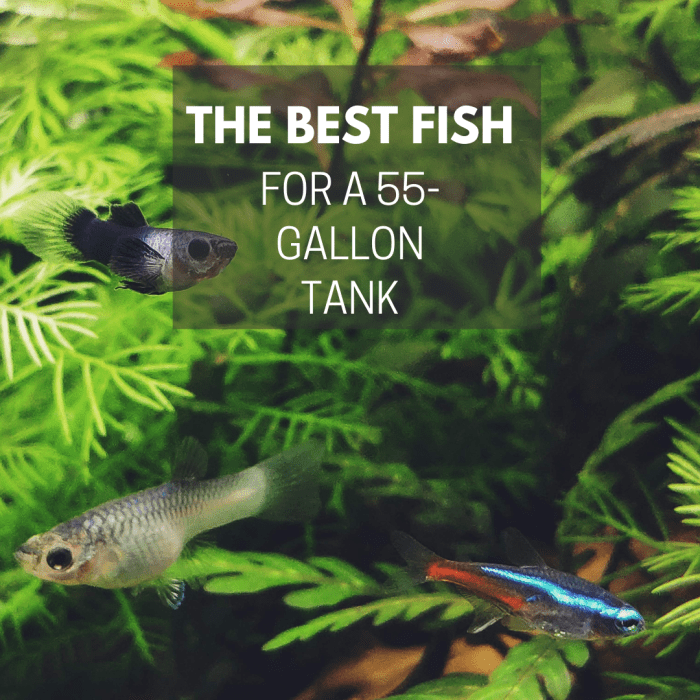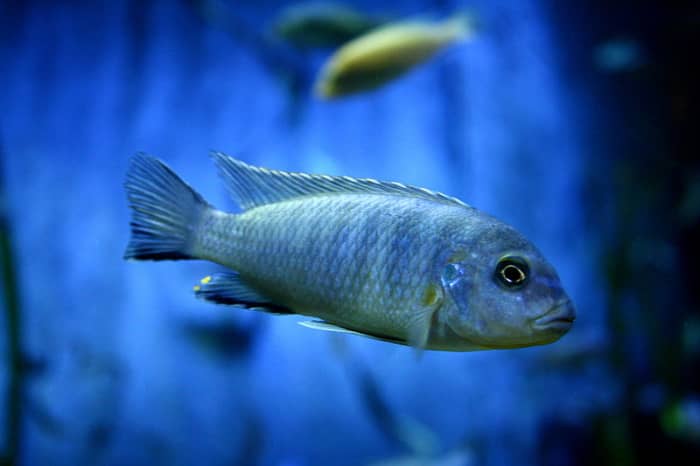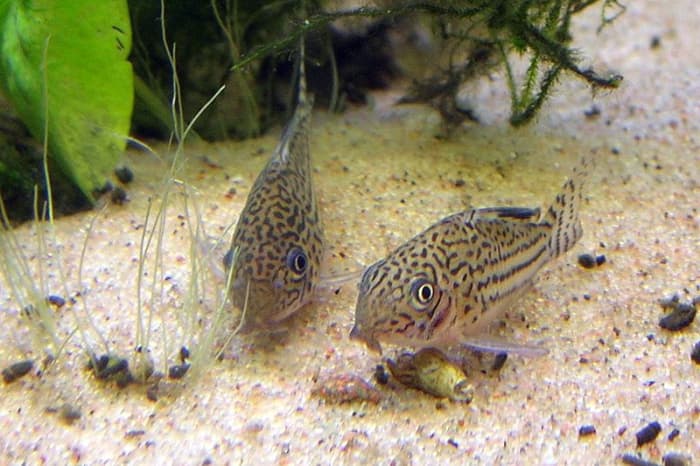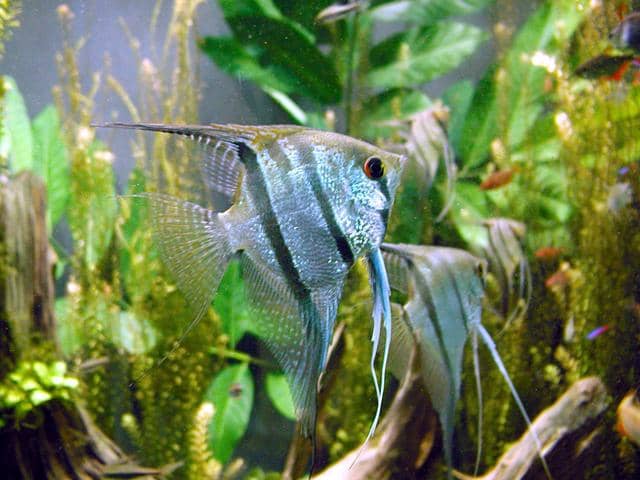Easy Fish for a 55 Gallon Tank
Eric is an aquarium enthusiast with over two decades of experience caring for a wide array of tropical fish.

Learn which fish are best for your 55-gallon tank and how to make smart choices when stocking your freshwater aquarium.
Photo by George Wong on Unsplash
A 55-gallon fish tank will be the focal point of any room. You may choose to build an aquarium with real driftwood, plants, and rocks, or you may instead go the artificial route. In either case, if you put in the effort and take some time to learn the ropes you can really create an incredible fish tank.
Of course, the fish you intend to stock play a very big part in how much success you have with your new aquarium. A 55-gallon tank may seem enormous, and it is a very big volume of water to have in a living room, but compared to a stream or lake it is pretty tiny. You still have a tight margin of error when it comes to making smart stocking decisions and choosing the right fish.
In my article on choosing fish for a 10-gallon tank, I laid out some basic rules for stocking an aquarium. Maybe you already have experience maintaining a smaller tank successfully. So, should you simply scale things up by several factors when stocking your 55-gallon aquarium?
You can do that if you want, but there is a better way that will give you many more options. It involves understanding the fish you intend to add to your tank, their temperaments, and where they will live in the aquarium.

A beautiful Cichlid Tank is a great choice for your 55-gallon aquarium.
Bardrock [GFDL or CC BY-SA 4.0-3.0-2.5-2.0-1.0], via Wikimedia Commons
Top 20 Fish for a 55-Gallon Freshwater Aquarium
Here is a list of the best fish for a 55-gallon tank:
- Cory Catfish
- Plectostomus
- Kuhli Loach
- Cherry and Ghost Shrimp
- Three-Spot Gourami
- Dwarf Gourami
- Angelfish
- Neon Tetra
- Cherry Barb
- Black-skirt Tetra
- Cardinal Tetra
- Bleeding Heart Tetra
- Fancy Guppy
- Swordtail
- Platy
- Molly Fish
- Zebra Danio
- African Cichlids
- Oscar
- Green Spotted Puffer
Read on to learn more about each fish as well as how to choose which are best for your aquarium.
How to Choose Which Fish to Stock
In small fish tanks, the fish are literally right on top of each other. These tanks are only a foot tall or so, and even if a fish is at the water surface it is still pretty close to a fish down at the substrate level.
A big tank like a 55-gallon is much roomier, dimension-wise, and this means you can start to think of your aquarium in terms of zones. Most fish have a specific area of the tank they prefer to inhabit and, while they will matriculate around the tank a bit, that is where they spend most of their time.
There is no valid "rule of thumb" to dictate how many fish you should have in your tank. However, there are numerous stocking calculators around the web if you really need hard and fast numbers.
Personally, when stocking average tropical community fish I've always thought about twenty to twenty-five fish was plenty for a tank this size. On the other hand, I've also had as few as seven in a 55-gallon tank. Really, it depends on the size of the fish, how much space they require, and where they will occupy that space in your tank.
Below you will read about some suggestions for stocking your tank. These suggestions are by no means intended as definitive advice, but only as ideas to get you started. You need to take the responsibility of researching your fish before stocking your tank, and you need to learn as much as you can about the species you intend to bring in.
Here's a look at the three different zones of your tank, and which type of fish to consider for each.
Scroll to Continue
Read More From Pethelpful

Cory Catfish are bottom dwellers that help to keep the tank clean.
By Soulkeeper (Own work) [Public domain], via Wikimedia Commons
Bottom Dwellers
The lowest level of your aquarium is right down at the gravel level. Some fish will spend their whole lives down there, surfacing only rarely and taking occasional swims at the higher levels.
Many of these fish are catfish of one type or another, but there are other fish and even some critters that will happily inhabit the netherworld of your fish tank. They are generally thought of as the "clean-up crew" because most are scavengers that will help keep your tank tidy.
Cory Catfish
These cute little guys will mop up any food that comes their way, thereby helping to reduce waste in your tank. But you should also feed them sinking pellets to make sure they are getting enough to eat.
You should keep them in schools of at least five, and up to ten total is an appropriate number for your 55-gallon tank. There are several varieties, so if you choose two different types be sure to stock them in groups of five.
Plecostomus
The Common Pleco is on the fence for a 55-gallon tank. They can grow very large, up to a foot or more, and they tend to get aggressive as they get older. In an under-stocked tank with other large fish, they may be okay, but the average tropical fish owner is probably better off going with a smaller species such as the Rubbernose Pleco.
All Plecos will eat algae on decorations and the glass but they also require driftwood in the tank and may trash your live plants. Supplement their diets with sinking pellets and algae wafers.
Loaches
The Clown Loach is a very popular aquarium fish, but it can grow to a foot long and should be kept in a school of five or more. For this reason, it is probably not a good choice for a 55-gallon tank, unless you plan to re-home as they get older. But you might consider smaller species like the snake-like Kuhli Loach.
Make sure to give them driftwood or other structures to hide under. Some loaches are even known to eat snails.
Cherry and Ghost Shrimp
You can have a whole legion of these little critters in a 55-gallon tank. They do a great job as scavengers, and they are fun to watch. They may even have more little baby shrimp if they manage to establish themselves in your tank.
But beware: Some fish may decide these guys are lunch. If you plan to stock large fish, you'll soon find your Ghost Shrimp population has become a ghost town.
Mid-Level Aquarium Inhabitants
In the middle of your water column, you'll find fish that spend a lot of time cruising around the vegetation and decorations. In many cases, they use it as cover and will inhabit a range from an inch or two from the gravel, up to several inches away from the surface.
Here are a few suggestions.
Three-Spot Gourami
A pair of three-spot gouramis are a beautiful addition to a 55-gallon tank, and many species grow to around 6-inches in length. But be aware that they can be aggressive toward each other, so be sure there are hiding spots that a harassed fish can escape into. Usually, they are slow-moving, docile fish that will spend most of their time floating around plants and other structures in your tank.
Dwarf Gourami
Also consider the Dwarf Gourami, a pretty fish that doesn't grow nearly as large as most gourami species.
Angelfish
One of the most popular tropical fish for sure, but in my opinion shouldn't be kept in a tank smaller than 55 gallons. They'll grow about a foot tall, so keep your tank décor under control so they don't tear their flowing fins.
Angels are really mid-to-upper level fish, as they'll spend a great deal of time near the surface as well. Take some time to research freshwater angelfish care before you stock them, as they have some unique care requirements.
Neons and Other Tetras
If you keep either of the fish listed above, you don't want neons in your tank unless you are planning to serve an expensive lunch. But if you keep your tank stock down to medium-sized fish, you can have a big school of neons.
These guys are only about an inch long, so you can stock 20 of them or more, as long as you aren't overstocking the rest of your tank. Along with some natural vegetation, a big school of neons really makes a tank pop.
There are lots of other pretty tetra species out there as well. Some of my favorites being black skirts, cardinals, black neons, and bleeding hearts. Most grow larger than neons and may be more appropriate with larger fish.
Cherry Barbs
These guys aren't very big, around the size of many tetras. The males have a bright red hue, and a school of six or eight is very pretty. They school loosely, often breaking off individually and spreading around the tank. But when perceived danger is present, such as the dastardly water-changer tube poking into the tank, they tighten up their ranks.

Anglefish make a beautiful addition to a 55-gallon tank.
mendel[CC BY-SA 1.0], via Wikimedia Commons
Top Swimmers
Some fish will inhabit the top portion of your tank, flitting around at the water surface with only occasional forays into the depths. They're typically small, quick fish, and adding a few can really liven up your tank. Of course, you want to be smart when stocking. Small fish at the surface are easy prey for larger fish lurking below.
Guppy
Guppies are very pretty and very lively, and they come in a bunch of colors. The only problem is they are also very small, and if you intend to stock guppies you need to take the same precautions as if you are stocking neons. Still, if you plan your tank right you can have a burst of colors at all levels of the water column.
Swordtail and Platy
Both are bright-orange fish with similar behaviors. In fact, in some cases, it is hard to tell the difference between a female sword and a platy. (A platy is typically a bit larger and bulkier.) Male swordtails have swords on their tails, so they are easy enough to distinguish. Stock a couple of females for every male sword. Both fish are available in many different varieties.
Mollies
Black molly, lyretail molly, sailfin molly, marble molly, and more. These are active fish and very popular in the aquarium industry. There are a lot of different types and hybrids out there. They are typically peaceful fish, but in some cases, mollies, and even platies, may harass other fish. The best defense against this is a well-stocked tank, so one fish does not receive the burden of harassment.
Zebra Danio
Adorable little striped fish, and very active. These are hardy fish, very docile, and you can have a school of them. The zebra danio also has the distinction of being the lucky fish genetically modified into the intriguing GloFish.
55-Gallon Species and Specimen Tanks
Hopefully, the suggestions listed above will get your mind turning. Remember, as the fish keeper it is your responsibility to research any fish you intend to bring into your aquarium and be sure they are a good fit with the rest of the stock.
For example, some fish are considered semi-aggressive and should be kept with other appropriate fish. It would be unwise to expect to mix them with docile species without incident. Planning your tank takes some research and a little effort, but doing it this way pays off in the end.
Researching fish and understanding their requirements before you bring them home is important if you want to run a successful aquarium. I have always found that a good reference book goes a long way when trying to make these decisions.
Are there easier ways? Sort of. Some fish keepers prefer to maintain species-only or single specimen tanks. In these cases, you don't need to worry as much about compatibility, but you do need to know what you are getting yourself into.
Here are a few ideas:
African Cichlid Tank
A 55-gallon tank is the minimum size you should consider if you intend to keep African cichlids. Bigger is even better! These are beautiful but highly aggressive fish that will stake out territory in your tank. Really, the footprint of the tank matters more than the height, as more ground space means more territory.
A community of African cichlids will establish a pecking order within their tank, from the dominant fish down to the weakest. For this reason, this is one of the rare cases when it is okay to slightly overstock (and over-filter) a freshwater tank. More fish means more targets for the dominant fish and ultimately less stress for the overall population.
If you intend to stock African cichlids please take the time to research their requirements thoroughly before building your tank. They are among the most colorful freshwater tropical fish, and a cichlid tank is a beautiful thing, but done wrong it can be a disaster. Learn as much as you can about them before proceeding!

You may choose to keep an Oscar in your 55-gallon Tank
Ashish Ghosh [CC BY-SA 3.0], via Wikimedia Commons
Oscar Tank
You can keep one oscar in your 55-gallon tank. Sound boring? If you think so, you don't know much about oscars. They're large cichlids, growing to over a foot as adults, and highly predatory. They also live for around a decade, so having an oscar is really more like having a dog or cat.
You should consider it as such, and care for it appropriately. These are fish with unique personalities. Oscar keepers report intelligent fish that learn to recognize their owners, and sometimes even allow themselves to be touched (can you pet a fish?).
This is a fish with specific needs, so once again be sure to do your homework before purchasing. In a 55-gallon tank, your oscar will have no tankmates, so you can set up a home just for him.
Green Spotted Puffer Tank
Like the oscar, the green spotted puffer can live for over a decade. These are fish that require a commitment, just like a dog or cat. But they are also among the most rewarding fish to keep. They are round, solid fish that grow to around six inches in length.
Green spotted puffers can live in freshwater as juveniles but will require brackish water as adults. Some puffer owners even keep their fish in marine setups as adults. But this isn't the only reason tankmates are hard to come by. GSPs are highly aggressive and will likely demolish any other fish in the tank.
Kept alone in a 55-gallon tank, a GSP makes for a great pet and a very cool tank setup. But, probably more than any other fish, the green spotted puffer requires a deep understanding of what you are getting yourself into before you purchase.
Do your research before bringing one home!
Good Luck With Your Fish Tank!
As you can see, you have many choices when it comes to stocking your 55-gallon tank. The take-away messages of this article should be:
- Consider the area of the tank a fish will inhabit when stocking.
- It's better to under-stock than over-stock.
- Big fish eat little fish! Don't mix little guys with big fish who could eat them.
- Be aware of the temperaments of the fish you intend to stock.
- Always research fish before you purchase.
- If you intend to keep a species or specimen tank really do your research before proceeding.
Good luck! Fishkeeping is a fun and rewarding hobby when done correctly, and choosing the right fish for your 55-gallon aquarium is the first step!
This article is accurate and true to the best of the author's knowledge. It is not meant to substitute for diagnosis, prognosis, treatment, prescription, or formal and individualized advice from a veterinary medical professional. Animals exhibiting signs and symptoms of distress should be seen by a veterinarian immediately.
© 2015 Eric Dockett
Eric Dockett (author) from USA on August 05, 2020:
@Kimberly - Probably, but you should do some research into the effects it can have on your water such as leaching tannins and lowering pH.
Kimberly K. on August 05, 2020:
Is it ok to add driftwood to my 55gal tank?
Eric Dockett (author) from USA on April 21, 2020:
@Lol idk - African cichlids and bala sharks are not a good match. African cichlids should be kept with other African cichlids.
Lol idk on April 20, 2020:
I have 3 bala Sharks in a 30 but im soon Gonna be upgrading them to a 100 gal. But one qeustion does anyone know if u can put african cichlids with bala sharks?
J on September 04, 2019:
An Oscar needs at least a 75 gallon aquarium, love the rest of the suggestions though
FISH BOY on June 11, 2019:
I am planning to add a lot of plants to the bottom layer since it looks natural and vibrant
fishy fishy on February 18, 2018:
i have a 29 g at home and thinking of upgrading to a bigger tank soon
peachy from Home Sweet Home on June 11, 2015:
I remembered my old fishes love the man made houses for them and the grasses
Source: https://pethelpful.com/fish-aquariums/Best-Fish-for-a-55-Gallon-Tank
0 Response to "Easy Fish for a 55 Gallon Tank"
Post a Comment